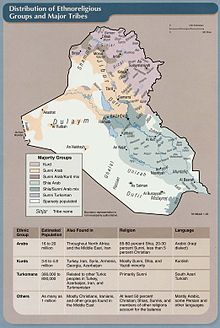
Back الدين في العراق Arabic İraqda din Azerbaijani ইরাকের ধর্মবিশ্বাস Bengali/Bangla دین لە عێراق CKB Religionsgemeinschaften im Irak German دین در عراق Persian इराक में धर्म Hindi Religioni in Iraq Italian 이라크의 종교 Korean Agama di Iraq Malay


Religion in Iraq dates back to Ancient Mesopotamia, particularly Sumer, Akkad, Assyria and Babylonia between circa 3500 BC and 400 AD, after which they largely gave way to Judaism, followed by Syriac Christianity and later to Islam.[1][2] Iraq consists of a multi-ethnic, multi-religious and multi-sectarian population, all living together in one geographical area. The Iraqi civilization was built by peoples and nations, including the Sumerians, Akkadians, Assyrians, Persians, Turks, Arabs, and Babylonians. Religious and cultural circumstances have helped Arabs to become the majority of Iraq’s population today, followed by Kurds, Turkmen, and other nationalities.
A national census has not been held since 1987.[4] In the 2020s, the country is overwhelmingly Muslim, who are split into two distinct sects, Shia and Sunni. Approximately 95% to 98% of the population are Muslims, with Shia Muslims constituting around 55%, and Sunnis around 40%.[5][6] The remainder follow Christianity, Yazidism, Mandaeism and Yarsanism.
- ^ "Mesopotamian religion | Facts, Names, Gods, Temples, & Practices". Encyclopedia Britannica. Retrieved 25 October 2021.
- ^ L. Sandler, Stanley (2002). Ground Warfare: An International Encyclopedia 3 volume set. ABC-CLIO. ISBN 978-1576073445.
- ^ "CIA data for Iraq". 25 May 2022.
- ^ "Iraq: Freedom in the World 2021 Country Report". Freedom House. Retrieved 3 January 2022.
- ^ Cite error: The named reference
CIAwas invoked but never defined (see the help page). - ^ Cite error: The named reference
PewResearchwas invoked but never defined (see the help page).